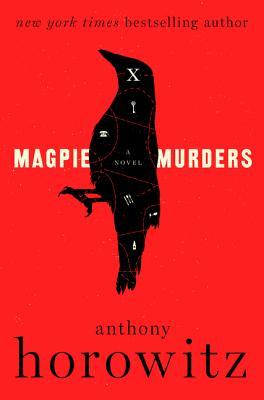There was going to be a funeral.Everything about Magpie Murders is meant to be ironic – embedding, as it does, pastiche within post-modernism – and while at first I found it interesting, the whole thing eventually began to drag and fizzle out. Author Anthony Horowitz drops the names of so many other famous authors into this narrative that I figure he must be friends with at least some of them, and I imagine this book gives them an opportunity to chuckle knowingly together over industry in-jokes. As this is a mystery, I wouldn't advise anyone to read beyond this paragraph to avoid even mild spoilers, but I do want to give a warning: There's some tricky business with the page numbering in this book, and when I flipped forward to see what was going on, I spoiled something for myself. My bottom line: Much like J. K. Rowling's (as Robert Galbraith) The Silkworm, this book succeeds more as a skewering of the publishing industry than it does as a straightforward mystery, and as with that book, your enjoyment here might be linked to how much you care about a wildly successful author's ironic take on said industry.
The first words of Magpie Murders.
The irony wasn't lost on me as I joined the other mourners who were assembling around the open grave.
As a sort of prologue, Magpie Murders begins from the point-of-view of editor Susan Ryeland as she settles down to read the latest manuscript by her small publishing house's best-selling author, Alan Conway. After the book-within-the-book's title page, author bio, and page of praise blurbs for Conway (attributed to everyone from Ian Rankin to Daily Mail), the manuscript begins. When the narrative abruptly ends just at the point where Conway's detective, Atticus Pünd, is about to reveal the killer, we return to “reality”, where Susan must play sleuth herself in order to track down the missing chapters; in the process uncovering a dark and dangerous “real life” mystery.
The embedded manuscript is a worthy pastiche of the Agatha Christie cosy cottage mystery – complete with a brilliant and fastidious, foreign-born detective. Any time I found something overwritten (I didn't mark the examples, but something like, “Despite the summer's heat, her chilly demeanor brought down the temperature in the room”), I smiled when I reminded myself that this was Alan Conway's writing, not Anthony Horowitz's. Having set his series in 1950's Britain, Conway is able to get away with mimicking the tone of that time:
There is something about the village of Saxby-on-Avon that concerns me. I have spoken to you before of the nature of human wickedness, my friend. How it is the small lies and evasions which nobody sees or detects but which can come together and smother you like the fumes in a house fire. They are all around us. Already there have been two deaths: three if you include the child who died in the lake all those years ago. They are all connected. We must move quickly before there is a fourth.So, it naturally becomes all wink-wink nudge-nudge when the narrative returns to “reality” and Susan becomes the detective:
In a whodunnit, when a detective hears that Sir Somebody Smith has been stabbed thirty-six times on a train or decapitated, they accept it as a quite natural occurrence. They pack their bags and head off to ask questions, collect clues, ultimately to make an arrest. But I wasn't a detective. I was an editor – and, until a week ago, not a single one of my acquaintances had managed to die in an unusual and violent manner.There's a general implausibility to the second narrative: strangers are happy to invite Susan into their homes and account for their whereabouts; an impatient police detective refuses to hear there might have been foul play despite obvious clues; Susan understands that coincidences make for bad fiction, but hey, this is “real life” and coincidences do happen. And this implausibility all seems part of the point: this reads like a huge po-mo wink; the reader is always aware that this is a book; Conway's publisher even balked at the title “Magpie Murders” because it sounds too much like “Midsomer Murders” – a series created by Horowitz himself. We eventually learn that Conway hated writing genre fiction (he wanted to be a “real” writer like Salman Rushdie or Will Self, and an excerpt of his “real” writing is terrible), and Susan's boyfriend dismisses Conway's writing as “badly written trash”; belittling the genre as “eighty thousand words to prove the butler did it”. Much is said about authors being pigeon-holed, rights and adaptations – all that industry stuff – and it all gets in the way of the mystery.
I doubt that Horowitz was trying to say here that he feels trapped in the mystery genre, but neither the embedded pastiche or the larger framing device really worked for me; it all felt a bit pointless, and as it is essentially two separate two hundred and fifty page books in one, it definitely felt too long. Ultimately, it read like an in-joke that I wasn't in on.

